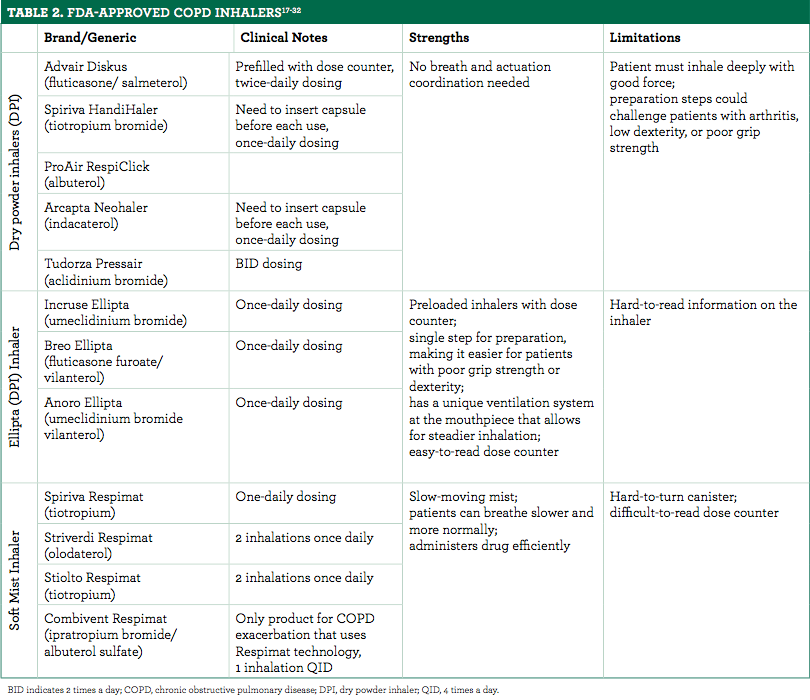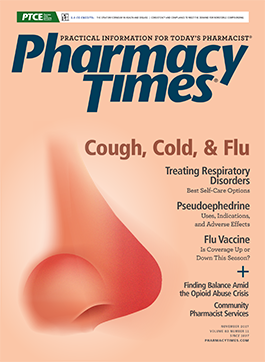Publication
Article
Pharmacy Times
COPD: Delving Into Inhaler Adherence
Author(s):
Chronic obstructive pulmonary disease (COPD)—irreversible—requires long-term adherence to pharmacotherapies for best outcomes.
Chronic obstructive pulmonary disease (COPD)—irreversible—requires long-term adherence to pharmacotherapies for best outcomes.1 Patients who are treatment adherent have lower likelihoods of exacerbation, hospitalization, and death. One study demonstrated that poor adherence to a combination inhaled corticosteroid (ICS)/long-acting b2-agonist (LABA) increases risk of hospitalization by 58% and death by 40%.2 Patients who are adherent also incur fewer costs than those who are not. Medication adherence in patients with COPD is very low, however,3 even though most individuals are aware of the disease’s progressive nature. The health care team needs to collaborate to ensure that patients with COPD use medications properly, consistently, and persistently.
First developed in the mid-1700s, inhalers are the bedrock of COPD management. Inhalers were quite rudimentary until 1956, when a young girl asked her father, a pharmaceutical company vice president, “Why can’t you make my asthma medicine like Mother’s hair spray?” This moment galvanized inhaler development.4
Inhaler adherence in COPD has many influences (see table 15).
Table 1. Factors Affecting Adherences in COPD
Factors
Examples
Patient-specific
- Cognitive abilities
- Comorbidities
- Conscientiousness
- Health beliefs
- Psychological profile
- Self-sufficiency
Health care provider—driven
- Device training
- Dosing regimen
- Method of administration
- Polypharmacy
- Adverse effects
Societal
- Access to medication
- Follow-up
- Patient—prescriber relationship
- Social support
Adapted from reference 5.
In the past, clinicians used several different methods to assess adherence. Often, they looked at the patient’s refill history, and some weighed the inhaler to see how much medication was left in the canister. These methods and patient self-report often misrepresent the patient’s adherence. Lately, researchers have found that 2 methods can help health care practitioners assess adherence in COPD.6
The first, the Morisky-Green test, guides clinicians to ask patients 4 questions that reflect the patient’s attitude toward medication:
- Do you ever forget to take your inhaled medication?
- Are you careless at times about taking your inhaled medication?
- When you feel better, do you sometimes stop taking your inhaled medication?
- Sometimes, if you feel worse when you take the inhaled medication, do you stop taking it?
Patients who answer yes to any of these questions may be nonadherent. Pharmacists should note that this method is also reliable in other disease states.6,7
The second, the Batalla test, helps clinicians assess how well patients understand their COPD. Here, too, the clinician asks the patient just a couple of questions and offers some basic information6,7:
- Is COPD a lifelong disease?
- Can you control this disease by quitting smoking and/or with medication?
- Mention 1 or more organs that can be damaged by COPD.
WHAT IMPROVES ADHERENCE?
Research associates several factors with better adherence. Patients who have been educated about their disease, believe in the treatment prescribed, and have realistic expectations are likely to be more adherent than others.8 Those who have little faith that their medications will work, are smokers, or have little confidence in their health care providers are more likely to be nonadherent.2
Patient beliefs about their medications are moving to the forefront as factors that increase adherence.9,10 Pharmacists who take the time to explain to patients how medications work, when to use as-needed doses, and what patients can expect will encourage adherence. Patients who have comorbid depression may need additional attention at the pharmacy, as they tend to be nonadherent.11
THE RIGHT MEDICATION, THE RIGHT INHALER
One area where pharmacists can have tremendous impact is in medication selection. Adherence tends to differ by medication class, and often, clinicians inquire about adherence by asking, “Are you using your inhalers?” Alternatively, clinicians should ask about each inhaler individually, rather than inhalers collectively, using open-ended questions. Patients may be adherent to 1 inhaler but not to another. Studies indicate that patients are probably more adherent to inhaled corticosteroids and LABA/ICS combination products than single-drug LABAs and muscarinic inhalers.12,13 Patients may or may not prefer once-daily dose administration,1,14 and this is an important point that pharmacists can explore.
Switching patients to generic inhalers can reduce costs, but it increases the likelihood of nonadherence unless patients are well educated.15 Results of studies of specific devices have also found important indicators of adherence. For example, patients with COPD are most likely to overuse their inhalers if their inhalers lack dose counters, use devices that allow dose loading without actual inhalation, or have devices that have no feedback mechanism.16
One group that deserves extra attention in the pharmacy is elderly patients. Memory loss, impaired cognition, and restricted mobility can significantly influence an older person’s ability to use an inhaler. table 217-32 lists FDA-approved COPD inhalers and their strengths and limitations.

END NOTE
By assessing 3 things—the patient’s needs and preferences, the patient’s adherence history, and the individual inhaler’s characteristics—pharmacists can help patients with COPD find the inhalers to which they are most likely to adhere.
Jeannette Y. Wick, RPH, MBA, FASCP, is a visiting professor at the University of Connecticut School of Pharmacy.
References
1. Toy EL, Beaulieu NU, McHale JM, et al. Treatment of COPD: relationships between daily dosing frequency, adherence, resource use, and costs. Respir Med. 2011;105(3):435-441. doi: 10.1016/j.rmed.2010.09.006.
2. Vestbo J, Anderson JA, Calverley PM, et al. Adherence to inhaled therapy, mortality and hospital admission in COPD. Thorax. 2009;64(11):939-943. doi: 10.1136/thx.2009.113662.
3. Rolnick SJ, Pawloski PA, Hedblom BD, Asche SE, Bruzek RJ. Patient characteristics associated with medication adherence. Clin Med Res. 2013;11(2):54-65. doi: 10.3121/cmr.2013.1113.
4. Rubin BK. Air and soul: the science and application of aerosol therapy. Respir Care. 2010;55(7):911-921.
5. Bourbeau J, Bartlett SJ. Patient adherence in COPD. Thorax. 2008;63(9):831-838. doi: 10.1136/thx.2007.086041.
6. Rogliani P, Ora J, Puxeddu E, Matera MG, Cazzola M. Adherence to COPD treatment: myth and reality. Respir Med. 2017;129:117-123. doi: 10.1016/j.rmed.2017.06.007.
7. Barnestein-Fonseca P, Leiva-Fernández J, Vidal-España F, García-Ruiz A, Prados-Torres D, Leiva-Fernández F. Is it possible to diagnose the therapeutic adherence of patients with COPD in clinical practice? A cohort study. BMC Pulm Med. 2011;11:6. doi: 10.1186/1471-2466-11-6.
8. World Health Organization. Adherence to long-term therapies: evidence for action. apps.who.int/iris/bitstream/10665/42682/1/9241545992.pdf. Published 2003. Accessed August 26, 2017.
9. Khdour MR, Hawwa AF, Kidney JC, Smyth BM, McElnay JC. Potential risk factors for medication non-adherence in patients with chronic obstructive pulmonary disease (COPD). Eur J Clin Pharmacol. 2012;68(10):1365-1373. doi: 10.1007/s00228-012-1279-5.
10. Ingebrigtsen TS, Marott JL, Nordestgaard BG, et al. Low use and adherence to maintenance medication in chronic obstructive pulmonary disease in the general population. J Gen Intern Med. 2015;30(1):51-59. doi: 10.1007/s11606-014-3029-0.
11. Qian J, Simoni-Wastila L, Rattinger GB, et al. Association between depression and maintenance medication adherence among Medicare beneficiaries with chronic obstructive pulmonary disease. Int J Geriatr Psychiatry. 2014;29(1):49-57. doi: 10.1002/gps.3968.
12. Mueller S, Wilke T, Bechtel B, et al. Non-persistence and non-adherence to long-acting COPD medication therapy: a retrospective cohort study based on a large German claims dataset. Respir Med. 2017;122:1-11. doi: 10.1016/j.rmed.2016.11.008.
13. Cecere LM, Slatore CG, Uman JE, et al. Adherence to long-acting inhaled therapies among patients with chronic obstructive pulmonary disease (COPD). COPD. 2012;9(3):251-258. doi: 10.3109/15412555.2011.650241.
14. Price D, Lee AJ, Sims EJ, et al. Characteristics of patients preferring once-daily controller therapy for asthma and COPD: a retrospective cohort study. Prim Care Respir J. 2013;22(2):161-168. doi: 10.4104/pcrj.2013.00017.
15. Braido F, Lavorini F, Blasi F, Baiardini I, Canonica GW. Switching treatments in COPD: implications for costs and treatment adherence. Int J Chron Obstruct Pulmon Dis. 2015;10:2601-2608. doi: 10.2147/COPD.S79635.
16. Koehorst-ter Huurne K, Movig K, van der Valk P, van der Palen J, Brusse-Keizer M. The influence of type of inhalation device on adherence of COPD patients to inhaled medication. Expert Opin Drug Deliv. 2016;13(4):469-475. doi: 10.1517/17425247.2016.1130695.
17. Center Watch. 2017 FDA approved drugs. http://www.centerwatch.com/drug-information/fda-approvals/. Accessed on September 8, 2017.
18. Geller DE. Comparing clinical features of the nebulizer, metered-dose inhaler, and dry powder inhaler. Respir Care. 2005;50(10):1313-1321.
19. Brand P, Hederer B, Austen G, Dewberry H, Meyer T. Higher lung deposition with Respimat Soft Mist Inhaler than HFA-MDI in COPD patients with poor technique. Int J Chron Obstruct Pulmon Dis. 2008;3(4):763-770.
20. Hanada A, Wada S, Ohno T, et al. Questionnaire on switching from the tiotropium HandiHaler to the Respimat Inhaler in patients with chronic obstructive pulmonary disease: changes in handling and preferences immediately and several years later. Int J Chron Obstruct Pulmon Dis. 2008;3(4):763-770.
21. Spiriva HandiHaler [prescribing information]. Ridgefield, CT: Boehringer Ingelheim Pharmaceuticals Inc; 2016. docs.boehringer-ingelheim.com/Prescribing%20Information/PIs/Spiriva/Spiriva.pdf. Accessed September 8, 2017.
22. Arcapta Neohaler [prescribing information]. East Hanover, NJ: Novartis Pharmaceuticals Corp; 2012. accessdata.fda.gov/drugsatfda_docs/label/2011/022383s000lbl.pdf. Accessed September 8, 2017.
23. Tudorza Pressair [prescribing information]. Wilmington, DE: AztraZeneca Pharmaceuticals LP; 2015. accessdata.fda.gov/drugsatfda_docs/label/2016/202450s006lbl.pdf. Accessed September 8, 2017.
24. Advair Diskus [prescribing information]. Research Triangle Park, NC: GlaxoSmithKline; 2017. gsksource.com/pharma/content/dam/GlaxoSmithKline/US/en/Prescribing_Information/Advair_Diskus/pdf/ADVAIR-DISKUS-PI-MG-IFU.PDF. Accessed September 8, 2017.
25. Breo Ellipta [prescribing information]. Research Triangle Park, NC: GlaxoSmithKline; 2017. gsksource.com/pharma/content/dam/GlaxoSmithKline/US/en/Prescribing_Information/Breo_Ellipta/pdf/BREO-ELLIPTA-PI-MG.PDF. Accessed September 8, 2017.
26. Incruse Ellipta [prescribing information]. Research Triangle Park, NC: GlaxoSmithKline; 2017. gsksource.com/pharma/content/dam/GlaxoSmithKline/US/en/Prescribing_Information/Incruse_Ellipta/pdf/INCRUSE-ELLIPTA-PI-PIL.PDF. Accessed September 8, 2017.
27. Anoro Ellipta [prescribing information]. Research Triangle Park, NC: GlaxoSmithKline; 2017. gsksource.com/pharma/content/dam/GlaxoSmithKline/US/en/Prescribing_Information/Anoro_Ellipta/pdf/ANORO-ELLIPTA-PI-MG.PDF. Accessed September 8, 2017.
28. ProAir RespiClick [prescribing information]. Horsham, PA: Teva Respiratory LLC; 2015-2016. proair.com/respiclick/library/docs/PI.pdf. Accessed September 8, 2017.
29. Combivent Respimat [prescribing information]. Ridgefield, CT: Boehringer Ingelheim Pharmaceuticals Inc; 2016. docs.boehringer-ingelheim.com/Prescribing%20Information/PIs/Combivent%20Respimat/CMVTRSPT.pdf. Accessed September 8, 2017.
30. Striverdi Respimat [prescribing information]. Ridgefield, CT: Boehringer Ingelheim Pharmaceuticals Inc; 2016. docs.boehringer-ingelheim.com/Prescribing%20Information/PIs/Striverdi%20Respimat/striverdi.pdf. Accessed September 8, 2017.
31. Spiriva Respimat [prescribing information]. Ridgefield, CT: Boehringer Ingelheim Pharmaceuticals Inc; 2017. docs.boehringer-ingelheim.com/Prescribing%20Information/PIs/Spiriva%20Respimat/spirivarespimat.pdf. Accessed September 8, 2017.
32. Stiolto Respimat [prescribing information]. Ridgefield, CT: Boehringer Ingelheim Pharmaceuticals Inc; 2016. docs.boehringer-ingelheim.com/Prescribing%20Information/PIs/Stiolto%20Respimat/stiolto.pdf. Accessed September 8, 2017.

Newsletter
Stay informed on drug updates, treatment guidelines, and pharmacy practice trends—subscribe to Pharmacy Times for weekly clinical insights.






